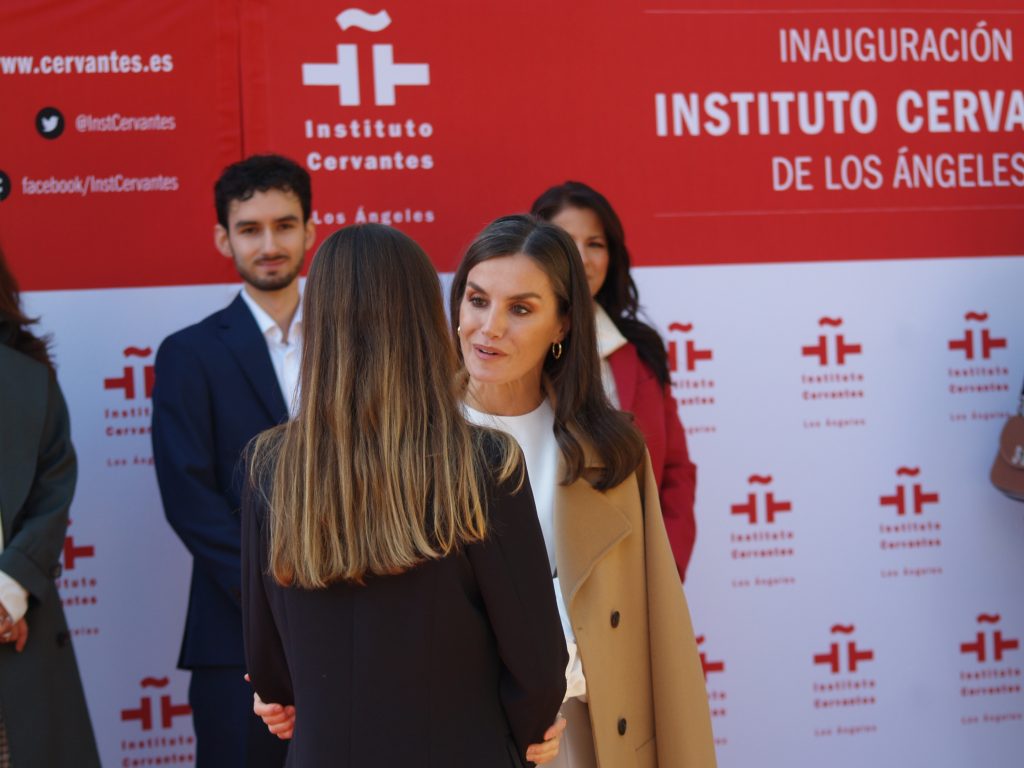

Spain’s Queen Letizia was in Los Angeles last month, not only to inaugurate the West Coast’s first branch of the Cervantes Institute but also to discuss and share ideas on the future of Spanish in the US.
Letizia, an experienced national television journalist and progressive feminist, officially opened the seventh Cervantes location in the US alongside Luis García Montero, global director of the Instituto Cervantes, and the writer Luisgé Martín, who is taking the helm of the LA institute. Unsurprisingly, there were plenty of Latinx celebrities at the event, including Kate del Castillo, Eugenio Derbez, Pedro Osuna, María Valverde, and Gustavo Dudamel, the Venezuelan conductor and head of the Los Angeles Philharmonic.
The new center’s library, dedicated to film-related materials in Spanish, is named after Oscar-winning director Pedro Almodóvar, who recorded a short film for the event in which he welcomed Spanish “however it’s spoken.”
Queen Letizia chaired a working meeting at the institute on the current situation of Spanish in the US and its prospects for growth. Luis García Montero summarized the objectives of the new center, while Richard Bueno Hudson, director of the Instituto Cervantes in New York, explained the challenges that “pan-Hispanism”—the coordination between Spain and other Spanish-speaking countries—poses for Spanish, its teaching, and its certification. According to him, the weight and the “diverse unity” of Spanish are reinforced by the development of Ibero-American linguistic and intercultural networks, the use of technological resources, and the new perspectives of the global world.
The director of Chicago’s institute, Anastasio Sánchez Zamorano, highlighted the agreement with CPS (Chicago Public Schools) to teach and implement the curriculum of the institute in public and private schools in the city, and the new program called Cervantes Bridges, which helps teach Spanish to the most disadvantaged students in the metropolitan area so that they can obtain their Seals of Biliteracy at the end of high school.
Albuquerque’s director, Silvia Rodríguez Grijalba, pointed out the unique position of her center being in New Mexico, a truly bilingual state, and explained that although Spanish is taught there, the institute offers literacy improvement programs and cultural activities to enhance knowledge of the cultural heritage of its Hispanic students.
Grijalba also gave an overview of the work they are doing in El Paso, where 80% of the population speaks Spanish. Under the name Pride and Heritage, classes are offered to children and adolescents to help them to improve their Spanish and to learn “and feel proud of the culture of their ancestors.”
LA director Martín said the city’s center would focus on the huge influence of Mexican and Central American cultures and the importance of the audiovisual industry. The new headquarters aspires to become a meeting place for Spanish-language creativity and the place for cinematographic and audiovisual creation in Spanish.
He also said, in a statement, that special attention will be devoted to second- and third-generation immigrants, whose relationship with Spanish is sometimes conflicted.
Spanish-language film producer Ignacio Darnaude emphasized the “explosive growth of Spanish and Latino in the world of entertainment,” as well as the “undeniable business figures” and “the pressure for the product generated by Hollywood to reflect the cultural diversity of the country.” “We have a golden opportunity to unite and leverage these forces, expanding Spanish and Latino culture in the US and around the world with the help of what unites us: the Spanish language,” said the producer.





